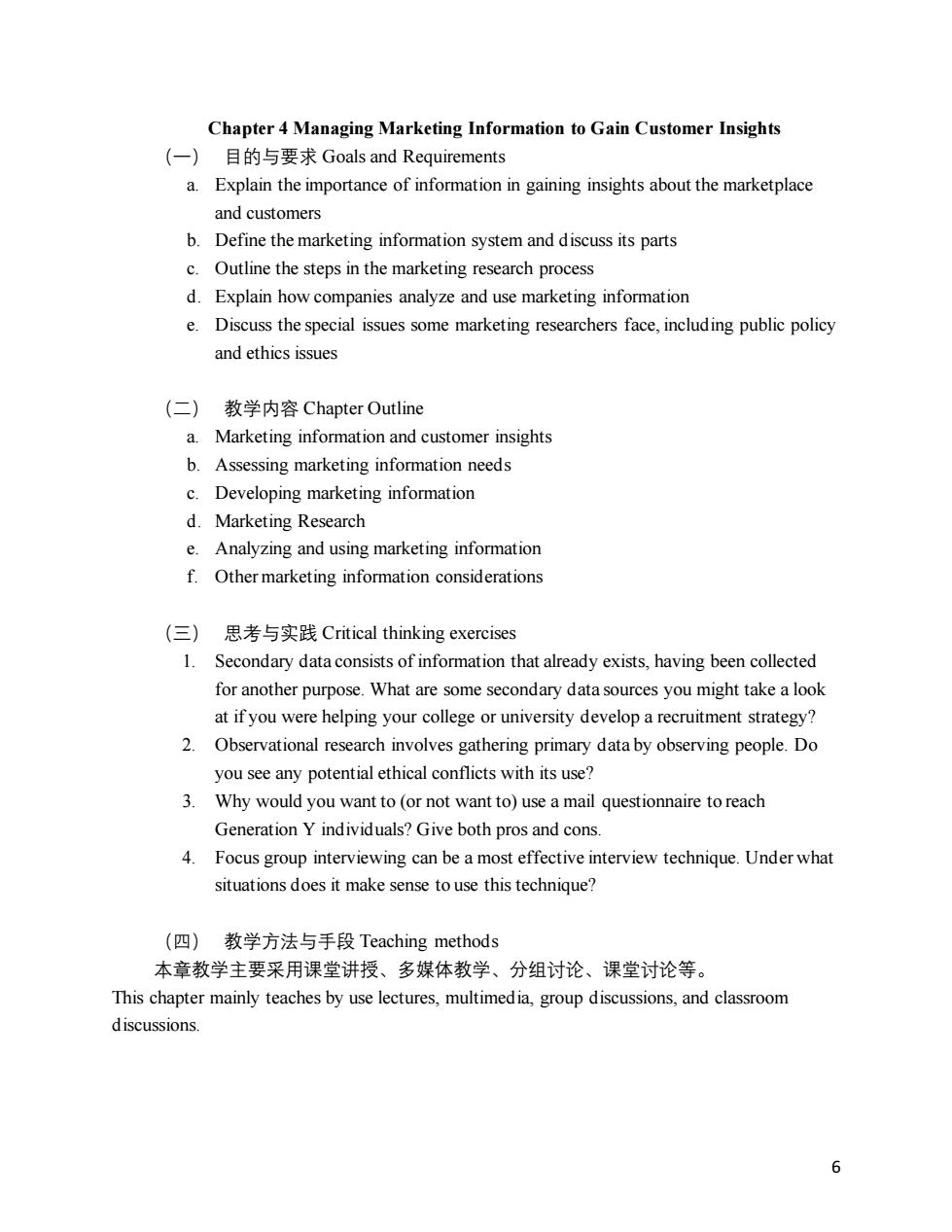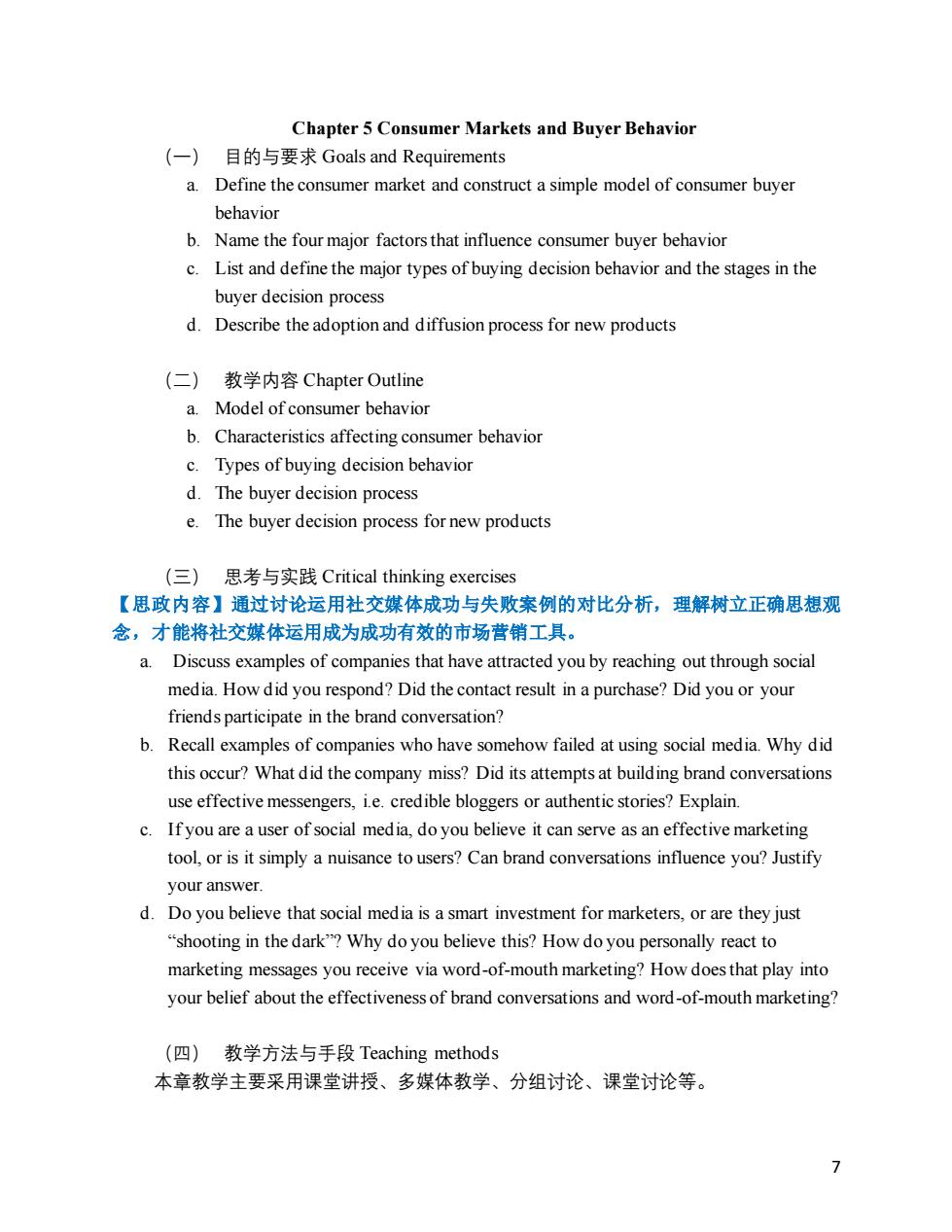
Chapter 4 Managing Marketing Information to Gain Customer Insights (一)目的与要求Goals and Requirements a.Explain the importance of information in gaining insights about the marketplace and customers b.Define the marketing information system and discuss its parts c.Outline the steps in the marketing research process d.Explain how companies analyze and use marketing information e.Discuss the special issues some marketing researchers face.including public policy and ethics issues (二)教学内容Chapter Outline a.Marketing information and customer insights b.Assessing marketing information needs c.Developing marketing information d.Marketing Research e.Analyzing and using marketing information f.Other marketing information considerations (三)思考与实践Critical thinking exercises 1.Secondary data consists of information that already exists,having been collected for another purpose.What are some secondary data sources you might take a look at if you were helping your college or university develop a recruitment strategy? Observational research involves gathering primary data by observing people.Do you see any potential ethical conflicts with its use? 3 Why would you want to (or not want to)use a mail questionnaire to reach Generation Y individuals?Give both pros and cons 4.Focus group interviewing can be a most effective interview technique.Under what situations does it make sense to use this technique? (四)教学方法与手段Teaching methods 本章教学主要采用课堂讲授、多媒体教学、分组讨论、课堂讨论等。 This chapter mainly teaches by use lectures,multimedia,group discussions.and classroom discussions
6 Chapter 4 Managing Marketing Information to Gain Customer Insights (一) 目的与要求 Goals and Requirements a. Explain the importance of information in gaining insights about the marketplace and customers b. Define the marketing information system and discuss its parts c. Outline the steps in the marketing research process d. Explain how companies analyze and use marketing information e. Discuss the special issues some marketing researchers face, including public policy and ethics issues (二) 教学内容 Chapter Outline a. Marketing information and customer insights b. Assessing marketing information needs c. Developing marketing information d. Marketing Research e. Analyzing and using marketing information f. Other marketing information considerations (三) 思考与实践 Critical thinking exercises 1. Secondary data consists of information that already exists, having been collected for another purpose. What are some secondary data sources you might take a look at if you were helping your college or university develop a recruitment strategy? 2. Observational research involves gathering primary data by observing people. Do you see any potential ethical conflicts with its use? 3. Why would you want to (or not want to) use a mail questionnaire to reach Generation Y individuals? Give both pros and cons. 4. Focus group interviewing can be a most effective interview technique. Under what situations does it make sense to use this technique? (四) 教学方法与手段 Teaching methods 本章教学主要采用课堂讲授、多媒体教学、分组讨论、课堂讨论等。 This chapter mainly teaches by use lectures, multimedia, group discussions, and classroom discussions

Chapter 5 Consumer Markets and Buyer Behavior (-)目的与要求Goals and Requirements a.Define the consumer market and construct a simple model of consumer buyer behavion b.Name the four major factors that influence consumer buyer behavior c.List and define the major types of buying decision behavior and the stages in the buyer decision process d.Describe the adoption and diffusion process for new products (二)教学内容Chapter Outline a.Model of consumer behavior b.Characteristics affecting consumer behavior c.Types of buying decision behavior d.The buyer decision process e.The buyer decision process for new products (三)思考与实践Critical thinking exercises 【思政内容】通过讨论运用杜交媒体成功与失败案例的对比分析,理解树立正确思想观 念,才能将社交媒体运用成为成功有效的市场营销工具。 a. Discuss examples of companies that have attracted you by reaching out through social media.How did you respond?Did the contact result in a purchase?Did you or your friends participate in the brand conversation? b.Recall examples of companies who have somehow failed at using social media.Why did this occur?What did the company miss?Did its attempts at building brand conversations use effective messengers,ie.credible bloggers or authentic stories?Explain. c.Ifyou are a user of social media,do you believe it can serve as an effective marketing tool,or is it simply a nuisance to users?Can brand conversations influence you?Justify your answer d.Do you believe that social media is a smart investment for marketers,or are they just "shooting in the dark"?Why do you believe this?How do you personally react to marketing messages you receive via word-of-mouth marketing?How does that play into your belief about the effectiveness of brand conversations and word-of-mouth marketing? (四)教学方法与手段Teaching methods 本章教学主要采用课堂讲授、多媒体教学、分组讨论、课堂讨论等
7 Chapter 5 Consumer Markets and Buyer Behavior (一) 目的与要求 Goals and Requirements a. Define the consumer market and construct a simple model of consumer buyer behavior b. Name the four major factors that influence consumer buyer behavior c. List and define the major types of buying decision behavior and the stages in the buyer decision process d. Describe the adoption and diffusion process for new products (二) 教学内容 Chapter Outline a. Model of consumer behavior b. Characteristics affecting consumer behavior c. Types of buying decision behavior d. The buyer decision process e. The buyer decision process for new products (三) 思考与实践 Critical thinking exercises 【思政内容】通过讨论运用社交媒体成功与失败案例的对比分析,理解树立正确思想观 念,才能将社交媒体运用成为成功有效的市场营销工具。 a. Discuss examples of companies that have attracted you by reaching out through social media. How did you respond? Did the contact result in a purchase? Did you or your friends participate in the brand conversation? b. Recall examples of companies who have somehow failed at using social media. Why did this occur? What did the company miss? Did its attempts at building brand conversations use effective messengers, i.e. credible bloggers or authentic stories? Explain. c. If you are a user of social media, do you believe it can serve as an effective marketing tool, or is it simply a nuisance to users? Can brand conversations influence you? Justify your answer. d. Do you believe that social media is a smart investment for marketers, or are they just “shooting in the dark”? Why do you believe this? How do you personally react to marketing messages you receive via word-of-mouth marketing? How does that play into your belief about the effectiveness of brand conversations and word-of-mouth marketing? (四) 教学方法与手段 Teaching methods 本章教学主要采用课堂讲授、多媒体教学、分组讨论、课堂讨论等